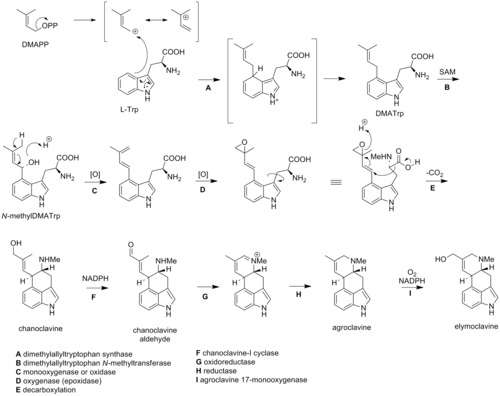Elymoclavine
 | |
| Names | |
|---|---|
| IUPAC name
(6-Methyl-8,9-didehydroergolin-8-yl)methanol | |
| Identifiers | |
| 548-43-6 | |
| 3D model (Jmol) | Interactive image |
| ChemSpider | 389734 |
| ECHA InfoCard | 100.008.136 |
| PubChem | 440904 |
| |
| |
| Properties | |
| C16H18N2O | |
| Molar mass | 254.327 |
| Except where otherwise noted, data are given for materials in their standard state (at 25 °C [77 °F], 100 kPa). | |
| Infobox references | |
Elymoclavine is an ergot alkaloid (ergoline alkaloid). It can be produced from C. fusiformis from Pennisetum typhoideum. It is a precursor in the biosynthesis of D-(+)-lysergic acid. Ergot alkaloids are natural products derived from L-tryptophan. They are often toxic for humans and animals. Despite that they are also well known for their pharmacological activities.[1][2]
Biosynthesis
The main building blocks for biosynthesis of elymoclavine are tryptophan (Trp) and DMAPP. DMATrp is obtained after electrophilic substitution followed by addition (Step A below). Then an amine is methylated by an N-methyltransfersase (Step B). Next, the allyl alcohol is oxidized to the diene (Step C). After 1,4-elimination, the diene undergoes an epoxidation (Step D). Then decarboxylation is followed by the 6-member ring formation and epoxide opened to form terminal alcohol (Step E). Obtained chanoclavine gets oxidized to chanoclavine aldehyde (Step F). Then the second 6-member ring forms and agroclavine is obtained after additional reductase (Steps G and H). Finally elymoclavine is generated after an oxidation (Step I). The last step is NADPH-dependent, and it is suggested that cytochrome P450 is the catalyst.[3][4]

References
- ↑ Ahimsa-Müller, M. A.; Markert A.; Hellwig S.; Knoop V.; Steiner U.; Drewke C.; Leistner E. (2007). "Clavicipitaceous fungi associated with ergoline alkaloid-containing convolvulaceae". J. Nat. Prod. 70 (12): 1955–1960. doi:10.1021/np070315t. PMID 18031017.
- ↑ Komarova, E. L.; Tolkachev O. N. (2001). Pharm. Chem. J. 35 (10): 542–549. doi:10.1023/A:1014706301632. Missing or empty
|title=(help) - ↑ Schardl, C. L.; Panaccione D. G.; Tudzynski P. "The Alkaloids - Chemistry and Biology".
- ↑ Dewick, P. M. (2009). Medicinal Natural Products. A Biosynthetic Approach. 3rd Edition. Wiley.